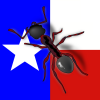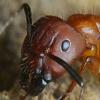I've never seen Cyphomyrmex before, but they sound a lot like Leafcutters. Trap-jaws live in Texas but I've never seen them as well.
Cyphomyrmex rimosus isn't really invasive like S. invicta. It is introduced though.The only species in that list that I've ever heard of is Pheidole..In my city we also have the invasive Odontomachus haematodus that can be found pretty easily when looking at the base of trees in shaded areas. Trachymyrmex septentrionalis is very common, however seem to be most active in the spring while they are excavating and expanding their nests. I find Cyphomyrmex rimosus (invasive) to be commonly found nesting in shaded areas very close to Pheidole dentata colonies for whatever reason.
It's a tiny fungus growing ant that grows yeast on caterpillar feces and bits of plants. It's pretty common in the warmer parts of the country (it may actually be the most common fungus grower where I am). They are pretty minute and unintrusive in my experience. They may be outcompeting native Cyphomyrmex wheeleri and other native attines, but I'm not sure.
Trachymyrmex is another fungus grower. They're larger and mostly use plants. They don't cut leaves, but are very closely related to the leafcutters.
Odontomachus is a large "trap-jawed" ant. There are a couple species in the US. I know there are supposedly native ones around where I am (I haven't seen them though -- they seem to be less common than Leptogenys and Pachycondyla or are less tolerant of disturbances).
Cyphomyrmex are pretty different from the leafcutters. They are very small (the workers are like 2mm, and the queens are like 3mm), live in tiny colonies (a few hundred), rarely have big, orderly columns, and are monomorphic. They are very easy to overlook. You've almost certainly got them where you are, considering how close you are to Houston and the gulf.
















